
EFL · National City (Philippines)
one Frame plate: national elements
Philippine Flag
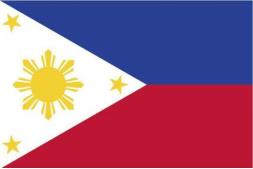
Landmark: Tubataha Reef Marine Park, Philippines
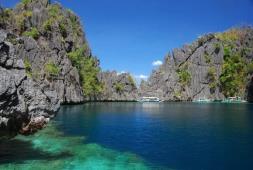
[Country name] Republic of the Philippines.
[Area] 299,700 square kilometers.
About 108 million people. Malays make up more than 85 per cent of the country's population. Other ethnic groups include Tagalog, Ilo, Pangbang, Visayas and Bikors. Minorities and foreign descendants include Chinese, Arabs, Indians, Hispanics and Americans; There are also a small number of aboriginal people. There are more than 70 languages. The national language is Filipino based on Tagalog, with English as the official language. About 85% of the people believe in Catholicism, 4.9% believe in Islam, and a small number of people believe in Independent Religion and Protestant Christianity. Most of the Chinese people believe in Buddhism, and most of the indigenous people believe in primitive religions.
Metro Manila, population 12.88 million (October 2015). The average annual temperature is 28℃.
[Head of State] Rodrigo Roa Duterte, since June 2016.
【 Important holidays 】 Independence Day (National Day) : June 12; Bataan Day (commemorating soldiers killed in World War II) : April 9; Hero's Day (to commemorate the martyrdom of Rizal, the father of the nation) : December 30; A major Christian festival, eg Christmas, etc
It is located in southeast Asia. Bashi Strait to the north and China's Taiwan Province far relative, south and southwest across the Sulawesi Sea, Barabak Strait and Indonesia, Malaysia face each other, west of the South China Sea, east of the Pacific Ocean. There are over 7,000 islands of all sizes, of which 11 major islands, including Luzon, Mindanao and Samar, account for 96 percent of the country's total area. The coastline is about 18,533 kilometers long. Is a monsoon tropical rain forest climate, high temperature and rain, humidity, more typhoons. The average annual temperature is 27℃, and the annual precipitation is 2000-3000 mm.
Implementation of the presidential system. The President is the head of state, head of government and commander-in-chief of the armed forces.
[Constitutional Law] Three constitutions have been promulgated since independence. The current Constitution was adopted by popular vote on 2 February 1987 and declared into force by President Corazon Aquino on 11 February 1987. The constitution stipulates that: the executive, the legislature and the judiciary have three separate powers; The president has executive power and is directly elected by the voters for a six-year term. He cannot be re-elected. The president has no power to impose martial law, dissolve parliament, or arbitrarily detain opponents. Banning military intervention in politics; Protecting human rights and outlawing individual dictatorships; Carry out land reform. Duterte has been committed to promoting the peace process in the southern Philippines since taking office. In early 2019, the referendum on the Law on the Organization of the Samoro Autonomous Region in the Muslim State of Mindanao was successful, marking positive progress in the peace process and national reconciliation in the southern part of the Philippines.
Parliament meaning in Chinese The highest legislative body is composed of the House and Senate.
【 Government 】 The cabinet of the current government was formed in June 2016.
[Administrative Divisions] The country is divided into three major regions: Luzon, Visayas and Mindanao. China has 18 regions, including the Capital Region, the Cordillera Administrative Region and the Muslim Autonomous Region of Mindanao, under which are 81 provinces and 117 municipalities.
Judicial power belongs to the Supreme Court and the courts at all levels.
[Political parties and organizations] There are more than 100 political parties of all sizes, most of which are small local parties.
[Economic] An export-oriented economy, which relies heavily on external markets. The tertiary industry plays a prominent role in the national economy, and agriculture and manufacturing also account for a considerable proportion. In the late 1960s, it adopted an open policy and actively attracted foreign investment, and achieved remarkable results in economic development. After the 1980s, the economic development slowed down significantly due to the economic recession in the West and the political turmoil in China itself. In the early 1990s, the Ramos government took a series of measures to revitalize the economy, and the economy began to fully recover and maintain a high growth rate. The Asian financial crisis that broke out in 1997 had little impact on the Philippines, but its economic growth slowed again. After President Duterte took office, he increased investment in infrastructure construction and agriculture and promoted tax reform. The economy maintained rapid growth, but it was also faced with problems such as high inflation, insufficient government financial resources and severe corruption affecting the economy. The main economic data are as follows:
GDP (2020) : about US $362.24 billion
GDP per capita (2020) : about US $3,300
GDP Growth Rate (2020) : -9.5%
Currency Name: Peso
Exchange rate (December 2020) : USD 1 ≈50 pesos
Inflation rate (2020) : 3.5%
[Resources] There are more than 20 kinds of copper, gold, silver, iron, chromium, nickel and so on. Copper reserves of about 4.8 billion tons, nickel 1.09 billion tons, gold 136 million tons. Geothermal resources are estimated to hold 2.09 billion barrels of crude standard energy. There are about 350 million barrels of oil in the waters off the northwestern island of Palawan.
[Industry] Industrial output reached 5.63 trillion pesos in 2019, up 5.2% year on year. Among them, the output value of mining, manufacturing, construction and electric water supply industries was 0.14 trillion pesos, 3.40 trillion pesos, 1.50 trillion pesos and 0.59 trillion pesos respectively, accounting for 0.6%, 15.3%, 6.7% and 2.6% of GDP. The Philippines' manufacturing sector mainly includes food processing, chemical products and radio communication equipment, accounting for more than 65 percent of its manufacturing output.
[Agriculture, Forestry and Fisheries] In 2019, the output value of agriculture, forestry, fishing and hunting is 1.55 trillion pesos, accounting for 7.0% of GDP. Our main export products are: coconut oil, bananas, fish and shrimp, sugar and sugar products, shredded coconut, pineapple and pineapple juice, unprocessed tobacco, natural rubber, coconut meal and seaweed.
The forest area is 15.79 million hectares, with a coverage rate of 53%. There are ebony, sandalwood and other precious wood.
There are more than 2,400 species of fish, and the tuna resources are at the forefront of the world. Already developed sea water, fresh water fishing ground area of 2080 square kilometers.
[Foreign Trade] As a member of the World Trade Organization (WTO), APEC and ASEAN, the Philippines is committed to promoting regional free trade and eliminating trade barriers by 2020. It has trade relations with 150 countries. In 2019, the Philippines' foreign trade volume stood at US $182.52 billion, a slight increase of 0.20% over the previous year. Among them, the export was $70.93 billion, up 2.34% year on year; Imports reached 111.59 billion US dollars, down 1.11%.
The Philippines' top 10 trading partners are China, Japan, the United States, the Republic of Korea, Hong Kong, Thailand, Indonesia, Singapore, Taiwan and Malaysia.
[Commodity Structure] In recent years, the Philippine government has been actively developing foreign trade, diversifying export commodities and foreign trade markets, and the structure of import and export commodities has undergone significant changes. Exports of non-traditional goods such as clothing, electronics, crafts, furniture and fertilizer have overtaken exports of traditional goods such as minerals and raw materials. The main exports of the Philippines are: electronic products, other manufactured goods, machinery and transportation equipment, spare parts for vehicles, fresh bananas, gold, refined copper, etc. The main imports are: electronic products, fossil fuels and lubricants, transport equipment, industrial machinery and equipment, iron and steel, mixed manufactured goods, other food and live animals, communications equipment and electrical machinery.
[Trade in Services] In 2019, the Philippines' net exports of trade in services were $13.05 billion, up 11.03% year on year. Among them, the export was US $40.97 billion, up 6.71% year on year; Imports reached 27.93 billion US dollars, up 4.25% year on year. Mainly distributed in other business services, tourism and communications, computer and information services and other fields.
Bilateral Trade: Economic and trade cooperation between China and the Philippines has developed rapidly. In 1975, when China and the Philippines established diplomatic ties, the bilateral trade volume was only US $72 million. In recent years, bilateral trade has maintained a momentum of sustained and rapid growth. China is the Philippines' largest trading partner, largest source of import and third largest export destination. According to Chinese customs statistics, in 2019, bilateral trade in goods (China only includes the mainland, the same below) reached 60.95 billion US dollars, with a year-on-year growth of 9.5%. Among them, China's exports to the Philippines amounted to US $40.75 billion, up 16.3% year on year. China's imports from the Philippines reached 20.02 billion US dollars, down 2.0 percent year on year.
China-Philippines trade statistics 2015-2019
(Unit: $100 million)

Source: China customs statistics
According to the statistics of the Chinese Customs, the main categories of Chinese exports to the Philippines in recent years include: 1) motors, electrical equipment and components; Sound recording and replayback equipment, their parts and accessories; (2) Boilers, machines, mechanical appliances and parts thereof; ③ Mineral fuels, mineral oils and their distilled products; Bituminous material; Mineral wax; (4) steel; ⑤ Knitted or crocheted clothing and clothing accessories.
According to Chinese customs statistics, the main categories of goods imported by China from the Philippines in recent years include: (1) motors, electrical equipment and components; Sound recording and replayback equipment, their parts and accessories; (2) Boilers, machines, mechanical appliances and parts thereof; ③ Boilers, machines, mechanical appliances and parts thereof; (4) edible fruit and nuts; The peel of a citrus fruit or melon; ⑤ Copper and its products.
(According to Philippine statistics, bilateral trade in goods reached US $34.16 billion in 2019, up 11.5% year on year and accounting for 19.2% of the Philippines' total trade. The Philippines imported US $24.54 billion from China, up 10.8% year on year, accounting for 22.9% of its total imports. Philippine exports to China reached $9.63 billion, up 9.2% year on year, accounting for 13.7% of the country's total exports.)
Filipino Culture
dress
Filipino Women's Clothing
Around the 16th century, Filipinos mostly wore clothes made of cotton yarn and hemp fiber. Men wear a jacket called "Kang Gang", collars, short sleeves, with a piece of cloth called "Baha" wrapped around the abdomen, the bottom of the jacket is slightly lower than the waist. The color of the clothes is blue or black, only the Zunlong red clothes. In the 21st century, upper-middle class Filipinos wear suits, while ordinary Filipinos wear simple clothes. Men wear shirts, like white, under the suit pants; Women like to wear collarless dresses. Most young people wear Western-style leather shoes, while the elderly still wear slippers made of wood, hemp or grass.
Filipino Muslim men wear short coats and baggy trousers with a "sallon" as a belt. Pilgrims to Mecca wear a white turban or cap on their heads. Women wore tight-fitting short-sleeved vests with double layers of metal buttons, baggy trousers with tight legs, or skirts. Women wear hairstyles like Malays, sometimes with brightly coloured headscarves, and they wear bracelets, necklaces and earrings.
The minorities wear different clothes. For example, Ifugao men often bare the upper body, the lower body around a T - shaped cloth; The women wore similar skirts in bright colors. Dinggang people clothes are very simple, men generally only in the abdomen around a piece of cloth, some also wear a jacket separated front; Women wear a jacket, with cloth around the abdomen, short black clothing is the most primitive, men and women are surrounded by cloth or leaves in the waist.
diet
The staple food of Filipinos is rice and corn.
Farmers pound rice before cooking. Rice is cooked in a clay bowl or bamboo tube and eaten by hand. Filipinos' favorite food is coconut water boiled tapioca, coconut water boiled rice, and then wrapped in banana leaves. Corn is used as food, first dried, ground into powder, and then made into a variety of foods. Most urban upper-middle class people eat western food.
Filipino Muslims' staple food is rice, sometimes corn and potato flour, accompanied by vegetables and fruits. In accordance with Islamic rules, they do not eat pork or drink hard liquor. Like other Malays like to eat fish and not drink milk. Cooking is very simple and likes to use pungent seasonings. Use your hands when eating. Chewing betel nuts is popular among Filipino Muslims.
marriage
Filipinos often marry after free love. In love, the man gives the woman more to wait with cosmetic, fruit, bouquet of flowers, the color of the flower is beautiful with white and peach, brown and red are the color that belongs to taboo. The marriage ceremony takes place in the church. Filipino Muslim marriages are decided by the parents. The man must propose to the woman's family through a matchmaker and pay the betrothal money. The wedding ceremony was presided over by an Islamic imam, and a grand banquet was held to entertain the guests. The Philippines has an early marriage system, and girls are considered marriageable at 12 or 13.
Baron Tagalog (Philippine Men's National Service)
Aboriginal people have various marriage customs. Igorot people living in the high mountains of North Luzon have two main ways of marriage, marriage by parents or free trial marriage. Generally speaking, wealthier families, in order to make their own family property, status will not fall apart, in the children are young by the parents of both sides engaged. At the age of 14 or 15, they were officially married. If one party expressed dissatisfaction after marriage, as long as the woman was not pregnant, they could separate at any time, and the men and women would find another partner. Infertile, can also be separated at any time. Pakistanians allow polygamous marriages, while Cousins are prohibited from intermarrying, and if those in the latter relationship marry, they must take "precautionary" measures and rituals, such as throwing valuables into the sea. If the man did not hit the bamboo tube placed by the woman in the distance, it showed that the man did not have the ability to support his wife, and it was difficult to achieve the purpose of marriage proposal.
In addition, the law in the Philippines stipulates that a man can have up to four wives. (Baidu Baike)
- Frame plate: hot news
(1), Canada and Belgium pork exports this year to the Philippines market is optimistic about http://news.foodmate.net/2021/05/593083.html - food partner network
(2) by the end of April, the Philippines sugar production of 1.85 million tons of http://news.foodmate.net/2021/05/593051.html - food partner network
(3) 210509 bulletproof youth club ZhiMin fans, for the new crown outbreak blocked the Philippines to open https://www.163.com/dy/article/G9I9F8340517853O.html, netease free food supply
(4) Community pantry has been set up in the Philippines, involving more than 20 areas. Is there one in your community? https://www.sohu.com/na/463077130_120589617 - sohu net
- Frame: countries, human geography
The Philippines (foreign name: Republika ng Pilipinas, full name is "Republic of the Philippines") is a multi-ethnic archipelago country in Southeast Asia. It is mainly divided into three island groups, Luzon, Misayas and Mindanao. There are more than 7000 islands of different sizes with numerous ethnic and cultural groups.
The Filipinos, whose ancestors were immigrants from the Asian mainland, established the Kingdom of Sulu, a maritime power, around the 14th century. In 1565, Spain invaded and ruled the Philippines for more than 300 years. After World War II, the Philippines was re-colonized by the United States and became independent in 1946.
The Philippines is a member of the Association of Southeast Asian Nations (ASEAN) and one of the 24 members of the Asia-Pacific Economic Cooperation (APEC).
(1) the Philippines night market snacks street food collection - bi li bi li at https://www.bilibili.com/video/BV1Lx411S7D8?share_source=copy_web
(2) the students some Philippines local super cheap chips junk food - watermelon video at https://www.ixigua.com/6935669112203018789
(3) Give Americans a taste of a Filipino delicacy, hairy duck eggs, and their reactions are hilarious! https://www.ixigua.com/6684631504829547016 - watermelon video
(4) in China to see the Philippines food, like noodles biological https://www.bilibili.com/video/BV1ux411M7uQ?share_source=copy_web - bi li bi
- Frame plate: the latest information (about 10 pieces)
(1) the Philippine special food safety regulatory system (at) http://news.foodmate.net/2020/11/576287.html - food partner network
(2) the Philippines banana exports fell 2020 https://www.cfsn.cn/front/web/site.newshow?newsid=49233 - China's food safety net
(3) the government agreed to food safety http://news.foodmate.net/2020/05/559414.html - food partner web development framework
(4) the Philippine government approval for food safety standards of agricultural frontline staff http://news.foodmate.net/2020/05/559413.html - food partner network
Nearly 2000 (5) the Philippines fruit poisoning food safety worries - People's Daily online at http://health.people.com.cn/n/2015/0716/c14739-27312272.html
(6) signed the minutes of cooperation between China and the Philippines to Indonesia to solve food safety problems - the Chinese government network at http://www.gov.cn/zfjg/content_788499.htm
(7) Ann | food customs: ban, directly or indirectly from the Philippines enter http://www.thepaper.cn/newsDetail_forward_4416864 -- surging news pig and pig products
The Philippine department of agriculture (8) support biotechnology promote agricultural products and food safety http://finance.eastmoney.com/a/201911271305422074.html - Oriental net wealth
two Professional frame plate
- Frame plate: Country, food introduction
Agriculture in the Philippines
The Philippines is an archipelagic country bordering the South China Sea to the west and north, the Pacific Ocean to the east, and the Celebes Islands (formerly known as Sulawesi) and Borneo (half Malaysian and half Indonesian) to the south.
The Philippines has a land area of 30 million hectares, 47 percent of which is agricultural land, mainly near cities and densely populated areas. 15.8 million hectares of woodland; 14.2 million hectares of usable land, 93% (13 million hectares) of which is agricultural.
Of the 13 million hectares of agricultural land, it is divided into areas for food, other food and non-food use. 31 percent (4.01 million ha) of land used for food, 52 percent (8.33 million ha) of land used for other food, and 17 percent (2.2 million ha) of land used for non-food. Of the land used for grain, 3.34 million ha is for corn and 3.31 million ha is for rice. For other foodstuffs, the largest area is 4.25 million hectares for coconut, 673,000 hectares for sugarcane, 59.1 hectares for industrial crops, 148,000 hectares for fruit trees, 270,000 hectares for vegetables and root crops, and 404,000 hectares for pastures. Of the agricultural land, 78.31 percent are most suitable for agriculture, and 6.1 million hectares are most suitable for farming.
There are three types of farms in the Philippines: large, medium and small. Most of the farms are small farms of about 2 hectares. They are single-grown and owned or managed by small farmers for subsistence or commodity production. In 1988 two-thirds of farms were less than 3 hectares and 85% were smaller than 5 hectares. In the decade leading up to 1996, small farms continued to expand. According to the Philippine Land Reform Commission, the government redistributed 4.1 million hectares of land to small farmers. Under the Land Reform Act, farmers cannot own more than five hectares of land. A typical farmer's family grows rice, corn and leaves, and raises a few livestock and poultry. Rice, maize, coconut and other crops are mainly produced by small farmers.
Agriculture, including forestry and fishing, plays a very important role in the Philippine economy. Seventy percent of the country's population is in rural areas. Two-thirds of the rural population depend on agriculture for their livelihood and half of the labor force is engaged in agriculture.
Philippine agriculture includes rice, corn, coconut, sugar cane, bananas, other crops, livestock, poultry and fishery production. The share of agriculture in GDP in 1995 was 23% and the growth rate was 3.2%. Much of the growth came from expansion of poultry, livestock and rice production.
As anyone who has tried Filipino cuisine knows, the Philippines is a meat eater's paradise. Filipino cuisine is very different from Malaysian and Thai cuisine, more influenced by the Spanish style. The food is usually sweet pork and chicken dishes, but there is also a lot of fried food, which is more to the taste of meat lovers. In the Philippines, there is less spicy and sour food like Thai food. Students who are afraid of spicy food can also enjoy it at ease. In addition to its sweet and sour local cuisine, the Philippines is also famous for its grilled cuisine and seafood. The main representative food is roast Suckling pig, roast pig leg, philipino barbecue, etc., fresh shrimp, green crab, fish and squid and other seafood. In addition, the Philippines is also famous for its fruit, especially mango. Any restaurant has a series of food about mango, as well as a lot of fruit desserts.
- Frame Plate: Food Standards [State Administration for Market Regulation]
- Framework: policies and regulations.
7.1 What are the regulations and policies on foreign trade?
7.1.1 Trade authorities
[Department of Trade and Industry] The Department of Trade and Industry (DTI), formerly known as the Department of Commerce of the Philippines, is the foreign trade policy making and management agency of the Philippines. The role of the Ministry of Trade and Industry is to formulate a comprehensive industrial development strategy and import and export policy; Creating an environment conducive to industrial development and investment; Promoting competition and fair trade; To be responsible for the negotiation of bilateral and multilateral investment and trade cooperation agreements; We will support the development of small and medium-sized enterprises and protect the rights and interests of consumers.
The routine work of the Ministry of Trade and Industry is to review and evaluate the country's export status, problems and prospects regularly. Determine the main problems affecting export development; To supervise the formulation and implementation of quality control by relevant departments to ensure the quality control of export commodities; To recommend to Congress legislation in favour of export development; To organize and participate in international trade exhibitions; Provide information services for domestic and foreign importers and exporters; Collate import and export trade database; Training of consumers and traders in their own countries; To examine and approve applications for the establishment of various chambers of commerce; Approving foreign enterprises to invest and set up factories in the Philippines; Issue import and export licenses.
The Product Standardization Bureau under the Ministry of Trade and Industry is mainly responsible for the management and implementation of product technical standards and regulations. The import services department is primarily responsible for the implementation of product-specific import legislation and for initiating and directing preliminary investigations into anti-dumping, countervailing and safeguard measures.
】 【 other departments and other trade related department: General Administration of Customs, the national economic development, the central bank, environmental administration, the ministry of health, transfer of technology department, bureau of food and pharmaceuticals, dangerous drugs bureau, bureau of fisheries and aquatic resources, national commission on meat inspection and quarantine, planning industry bureau, bureau of energy management and clothing export, etc. The Customs Commission under the National Economic Development Agency (NEDA) of the Philippines is responsible for tariff policy, including tariff concession, tariff variation, tariff refund, anti-dumping and countervailing public hearings and consultations, and safeguard investigation. The Customs Office under the Ministry of Finance of the Philippines is responsible for the implementation of customs laws and the collection of import and export duties, value-added taxes on imported products and other additional taxes.
7.1.2 Trade legal system
As a member of the World Trade Organization (WTO) and the Asia-Pacific Economic Cooperation (APEC), as well as of the Association of Southeast Asian Nations (ASEAN), the Philippines pursues a multilateral, liberal and outward oriented trade policy with appropriate protection of its domestic infant industries. The Philippine government has continuously adjusted its trade policy and introduced a series of export encouragement measures.
The laws governing Philippine import and export trade mainly include the Customs Act, the Export Development Act, the Anti-dumping Act, the Countervailing Act, and the Safeguard Measures Act.
7.1.3 Relevant provisions on trade management
The Philippine Customs Modernization and Tariffs Act (CMTA) classifies imported goods into four categories: free import goods; Control of imported goods; Restrict the import of goods; The import of goods is prohibited.
(1) Proscribed Imports (CMTA, Chapter 3, Section 118) : printed articles that are subversive to the State or in violation of Philippine laws; Commodities, tools, medicines, advertisements and printed materials used in illegal abortion; Printed matter or media products that contain unethical content; Commodities containing precious metals such as gold and silver and not marked with quality and purity; Food or medicine in violation of local regulations; Goods that infringe intellectual property rights; The import of goods prohibited by laws and regulations promulgated by other competent authorities.
(2) Restricted importation of goods (Section 119, Chapter 3 of CMTA) : Unless authorized by laws or regulations, the import of the following goods is prohibited: firearms, ammunition, explosives and other weapons; Gambling equipment; Lottery tickets and raffle tickets; Drugs, addictive substances and derivatives proscribed by the President of the Philippines; Toxic and hazardous goods; Other goods subject to restrictions.
(3) Controlled Imports (CMTA, Chapter 3, Section 117) : Controlled imports must be imported with a license or authorization from the appropriate authority. A list of controlled imports can be found in the Philippine National Trade Database.
(4) Free Import of Goods (CMTA, Chapter 3, Section 116) : Goods other than prohibited, restricted, or controlled imports may be freely imported into or out of the Philippines unless otherwise provided by laws and regulations.
Export products export commodities management 】 【 also according to the Philippine customs modernization and tariff act, the Philippine government generally to encourage policy on export trade, mainly including simplified export formalities and shall be exempted from export surcharge, imports and exports can enjoy VAT rebate, foreign aid and the use of low-cost facilities such as export processing zone. Mineral products are classified into prohibited export commodities, restricted export commodities, controlled export commodities and free export commodities.
7.1.4 Inspection and quarantine of import and export commodities
The Philippines is a signatory to the Technical Barriers to Trade Agreement (TBT) as part of the Tokyo Round of the General Agreement on Tariffs and Trade. The technical agreement requires government agencies to be open when adopting standard procedures and establishing dispute settlement review procedures. The purpose is to ensure that government agencies comply with these provisions. The Philippine Product Quality Authority (PQB) is the agency responsible for product quality standards. It promotes product quality through quality management certification, and manages imported goods by pasting conformity marks on them. The applicable standards are ISO9000 and ISO14000.
[Commodities related to people's livelihood, health, safety and property] The Department of Trade and Industry of the Philippines requires product standard permits and certification from the Product Standards Authority. These products include: medical oxygen, consumer goods, electrical and fire protection equipment, building materials, etc. The import of articles, instruments and meters of non-metric weights and measures shall be licensed in advance by the PSA.
The Philippine Department of Environment and Natural Resources is responsible for implementing the government's environmental protection policies. The importer should comply with the requirements and regulations of environmental protection.
[Food Health and Safety Regulations] In respect of food, Ingredients, additives, non-alcoholic beverages and blends, confectionery, coffee, tea, pastries, dairy products, vegetables, fruits, meat, etc. must meet the standards set by the Codex Alimentarius Commission and the World Organization for Animal Health (OIE); Fresh and frozen fish products must be issued with an International Health Certificate and Sanitary Plant Quarantine Certificate as stipulated in Administrative Regulations 195 issued by the Department of Agriculture of the Philippines in 1999. A certificate of disinfection should be provided if vegetables and fruits are imported from areas where pests are present; Cosmetics and medicines must be produced with a production license, and the clinical trial report of an international certification body must be provided. The import of dangerous goods must be labeled and sold in accordance with the standards of the Ministry of Health of the Philippines. Related dangerous goods include irritants and corrosive, flammable and radioactive substances.
At present, the plants and plant products 】 【 plants and plant products to enter the Philippines market must be below the quarantine formalities: exporters will invoice and packing notice o Philippine importer, importers exporters on invoice and packing one-way agriculture crop plant quarantine bureau (BPI) to apply for import license, we will indicate the offshore before each product requirements. The importer will give the certificate to the exporter, who will request the quarantine authority of the exporting country to have the product quarantined offshore and issue the quarantine certificate. The exporter shall forward the quarantine certificate together with other transport documents to the importer in the Philippines by the appropriate means. After the goods arrive in the Philippines
After the port, the importer will provide the import license and the quarantine certificate of the exporting country to the Philippine quarantine authority. The quarantine department of the Philippines shall conduct re-inspection according to the import license and quarantine certificate. Only qualified ones can enter the customs.
[Animals, Animal Products and Their By-Products] The Animal Industry Bureau of the Philippine Department of Agriculture is the government agency responsible for the import and export quarantine of animals, animal products and their by-products. The Animal Industry Bureau has different import and export procedures and quarantine regulations for different animals.
3.1.5 Customs management rules and regulations
On May 3, 2016, the Philippines promulgated a new import and export management law, the Philippine Customs Modernization and Tariff Act (CMTA). The rates of import duties are determined and announced by the Customs Commission of the Philippines
(www.tariffcommission.gov.ph), the export tariff rate determined by the General Administration of Customs, and by the customs by the Philippine central bank collection.
The Philippines imposes AD valorem tariffs on most imports, but imposes specific tariffs on alcoholic beverages, tobacco products, watches, fossil fuels, saccharin and other products. Customs duties are levied on automobiles, tobacco, gasoline, alcohol and other non-essential goods. Imports are also subject to a 12 per cent value-added tax levied by the Philippine Customs Authority, based on the assessed value of the Customs plus the duties and excise levied.
Since 2018, the Philippines has fully implemented the preferential tariffs under the China-ASEAN Free Trade Area (ACFTA) (the latest upgraded version has been implemented since 2019), and import and export tariffs on trade between China and the Philippines have been significantly reduced. With the basic realization of free trade between China and ASEAN, the flow efficiency of production factors such as capital, resources, technology and human resources has been significantly improved, and the economic cooperation between the two sides has reached a higher level.
[Import Tariff] The Philippine import tariff rate is usually 0-30%. Specific commodity rates can be found from the tariff commission of the web page, the url is: www.tariffcommission.gov.ph/tariff_finder.
[Import Quota] The Philippines implements tariff quota management measures on some agricultural products, such as rice. Products within the quota are subject to normal tariffs, while those outside the quota are subject to high tariffs.
[Zero Tariff Within ASEAN] According to the agreement within ASEAN, the Philippines applies zero tariff to all imports of products from ASEAN member states.
[Export Tariff] The Philippines only imposes a 20 percent export tariff on logs.
[Export Tax Rebate and Export Preferences] Under the Philippine Export Development Program, the Investment Agency of the Philippines
(BOI) or PEZA registered and qualified export enterprises can enjoy the corresponding tax preferences, including corporate income tax reduction, import tariff and fee reduction, etc. Relevant policies can be found in the website of the Investment Bureau or the website of the Economic Zone Administration.
7.2 The Philippines' export trade policy
The Philippine government has adopted policies to encourage export trade, and has adopted preferential policies for export-oriented enterprises in the Investment Law and related laws and regulations, and promulgated the Export Development Law in 1994.
7.2.1 Export encouragement policies
Exporters enjoy a variety of export incentive policies, including simplified export procedures and exemption from export surtax. Exporters can keep 100% of the foreign exchange earnings from exports and are free to use them for any purpose. Exporters also enjoy VAT rebates for re-export of imported goods, foreign exchange assistance and access to low-cost facilities in export processing zones. Export producers may import raw materials needed to produce export goods on consignment or duty-free under the rebate program.
Export financing is available to all Filipino exporters. Without the approval of the central bank, exporters can apply to the local authorities for letters of credit, foreign exchange loans for purchase contracts or sales contracts. In the form of guaranteed commercial contracts, the central bank stipulates that commercial banks lend to exporters at lower interest rates than government bonds and provides financial support to export-oriented enterprises for labor-intensive export products using local raw materials.
The Philippines has also set up export processing zones, bonded warehouses and various types of industrial parks to provide incentives on raw materials and customs duties.
7.2.2 Management of export commodities
The Philippine government encourages export to earn foreign exchange. With the exception of certain commodities restricted by national interests and laws, the vast majority of commodities are freely exported without restrictions. Exports fall into three categories:
- Free export commodities;
B, restrict the export of commodities (such commodities need the approval or permission of the competent authorities of the government);
- Goods prohibited from export (goods prohibited from export by law).
7.2.3 Other provisions
1, limit unfair competition, anti-dumping and countervailing duty assessment.
- Quota restrictions, mainly for textiles and clothing.
7.3 Philippine Import Trade Policy
7.3.1 Import commodity management
The Philippines permits, in principle, the importation of all commodities, which can be classified into three categories:
- Free import of goods;
- Restricting the import of goods (prior approval from the competent authorities is required);
- Prohibition of the import of commodities (commodities that are harmful to public health, national security, international commitments and local industrial development).
7.3.2 Quotas and licenses
A quota,
Currently, about 137 items are subject to quantitative restrictions, while 60 items require absolute quantitative restrictions.
- Import License
Mainly agricultural products. About 130 varieties require import licenses, accounting for about 4 percent of imports.
7.4 Compulsory technical standards
7.4.1 Product requirements and technology
The producer or the merchant exporting to the Philippines shall comply with the requirements of the Philippine importer to specify the specifications of the goods to be imported in the contract.
7.4.2 Environmental protection and pollution control
The importer should comply with the requirements and regulations of environmental protection.
7.4.3 Food, health and safety provisions
7.5 Labels and Marks
7.5.1 General Provisions
The imported goods must contain the following contents: the registered trademark name, the registered trademark, the registered company name, the address of the producer or importer, the main composition of the goods and the net quantity.
7.5.2 Special Provisions
Some commodities may be subject to special government regulations, such as requirements to indicate other characteristics of the product.
7.6 Relevant domestic media reports
Support (1) the Philippine intellectual property office of the environmental protection product http://www.ipraction.gov.cn/article/xwfb/gjxw/202102/335694.html -- China to crack down on infringement of fake job network
(2) experts advise Philippine startups to actively carry out the patent analysis work http://www.ipraction.gov.cn/article/xwfb/gjxw/202105/344108.html -- China to crack down on infringement of fake job network
- Frame plate: exhibition and exhibition (food)
(1) WOFEX, World Food Show, Philippines
http://www.yshows.cn/zhanhui/22.shtml - outreach network
The basic information
Name (English) : WOFEX, World Food Fair Philippines, 2021
Name (English) : Wofex
Exhibition Date: August 00, 2021 - August 00, 2021
Venue: Manila, Philippines
Exhibition cycle: once a year
Sponsor: PEP Group
Organizer: Beijing Zhongling International Exhibition Co., Ltd
Industry attributes
Food, beverage, alcohol, tobacco
Exhibits range
Food and beverage products: baked goods, canned goods, cheese, chocolate, coffee products, biscuits, confectionery, dairy products, flavorings and spices, frozen meat, fruits and vegetables, fruit juices, wines, flavored snacks, processed foods, seafood products, snacks, teas, wines and spirits, etc.
Food equipment: appliances, baking equipment, bar equipment, knives, coffee POTS, vending machines, tableware, food trucks, glassware, kitchenware, tablecloths, plastic products, display/display cabinets, tableware, others.
Products and services: barcode, franchise, furniture/fixed parts, printing, handling equipment, Internet service, labeling machines, packaging equipment, signage, trade publications, vending machines.
The exhibition to introduce
Wofex is the largest and most professional food and beverage show in the Philippines. It is organized by Pepgroup, a well-known organizer in the Philippines. Among them, Wofex has five characteristics. With these advantages and characteristics of Wofex, your participation will bring you unlimited business opportunities and fully explore the food market in the Philippines. The five features are:
Wofex is still the largest food show in the Philippines, with many new and old exhibitors and trade visitors coming every year. The event will bring the latest and best products and services from food and beverage industry suppliers, new exhibitors and other top performers in new industries. With the arrival of more and more international exhibitors, Wofex has become a truly outstanding international food show.
② A variety of activities: Although the exhibition is the theme of Wofex, there are many exciting activities attached to it that can attract more buyers and trade visitors. During the 4-day exhibition, three large conference venues and two outdoor venues will be held simultaneously, presenting wonderful food activities such as: baking technology demonstration, cooking technology demonstration, etc. Wofex will show you all the Filipino specialties. There is no precedent for such an event in the Philippine exhibition industry. Obtained numerous exhibitors and visitors of the high praise.
③ Exciting food competition: Wofex continues to host this competition for professionals. This is the only food competition authorized by the World Association of Chefs Societies (WACS) in the Philippines. The "Philippine Cuisine Cup" attracts chefs and teams from around the world to test their cooking skills each year.
Growth of buyers and professional audiences: As Wofex grows in importance in the Philippines and the region, so does the number of buyers and trade audiences. It broke the 50,000 mark in 2006 and has maintained a rapid growth every year since then.
④ Meetups for exhibitors and trade visitors: For the past 11 years, Wofex has been holding on-site meetings for exhibitors, introducing them to the most powerful buyers and purchasing groups in Singapore. Many exhibitors have benefited from this service.
In short, on Wofex, you can seek the latest products, new distributors, authoritative industry information, new partners, innovative product technology, sign new sales contracts, contact company decision makers, show your latest products, visit cooking competitions, and enjoy the pleasure of selling products on site. Wofex is the perfect choice for your food market in the Philippines. Don't miss the boat.
The market background
The Philippines is located in southeast Asia, bordering the South China Sea on the west and the Pacific Ocean on the east. It is an archipelago country, with a total of 7,107 islands. These islands are scattered like shining pearls in the vast expanse of blue water in the western Pacific, and hence the Philippines is known as the "Pearl of the Western Pacific". According to statistics, the annual population growth rate of the Philippines is 2.04%, making it one of the countries and regions with the highest population growth rate in Asia. Agriculture in the Philippines plays an important role in the national economy, but because of its special location, Filipino food grains such as rice, wheat and corn are mainly imported. The Philippines is also a food exporter, with processed, fresh and organic foods playing an important role in its exports. The United States, Japan, Europe, South Korea and the Middle East are the major destinations for Filipino food exports. As exports surge, the Philippine food industry is increasingly demanding imported food ingredients, additives, packaging materials, and equipment.
(2) the 29th the Philippines international food and food processing and packaging exhibition the AFEX http://www.yshows.cn/zhanhui/632.shtml
The exhibition profile
※AFEX is the largest and most influential food and equipment show in the Philippines. AFEX has achieved remarkable results, increasing the number of exhibitors, professional visitors and turnover rate year by year, making the show a pivotal position in the Philippine food and beverage industry, becoming a major source of information on the latest products and technologies in the industry.
Previous review: In 2017, there were 551 exhibitors and 40,000 visitors, including 340 international exhibitors with an exhibition area of 11200 square meters. There are 44 exhibitors from China.
Label: barcode, label machinery, label printing press; Food safety and hygiene technology; Laboratory testing, testing and analysis instruments and equipment; Material handling and storage systems; Meat processing and packaging technology; Anticorrosive packaging; Automatic processing control equipment and systems; Adhesive system;
Exhibits range
Bag sealing machine, filling machine; Carton packing machine; Box making machine; Sealing machine; Carrageenan; Kitchen equipment; Refrigerating equipment, heating machine, dryer; The ice maker. Baking equipment; Beverage equipment, brewing equipment and technology; Biscuit making machine; Blender; Boiler, steam engine; Bottling machine, filling system and technology; Cake making machine; Filling machine; Diet equipment; Cleaning equipment; The coffee machine; Candy machine; Consulting management, project management; Beverage bottle and filling machine; Conveying equipment; The dishwasher. Food ingredients; Food packaging equipment; Food processing equipment; Machinery and equipment for ice-cream production; Food quality control testing instruments and equipment; Machining control technology; Refrigeration, refrigeration and storage equipment; Seafood food processing equipment; Storage system, store facilities, display cases; Sewage treatment equipment and technology; Weight and quantity measuring apparatus, laboratory equipment; Bale press and technology.
- Frame plate: food category
- Dried mango
Mango is also known as "Wangguo", which means "fruit of hope". The fruit is elliptical and smooth, the peel is lemon yellow, and the taste is mellow. Beautiful shape and color, mango taste sweet and sour, cool and non-toxic, with Qingreshengjin, thirst diuresis, benefit stomach stop vomiting and other functions.
Philippine dried mango is different from the common dried fruits and vegetables. The dried mango is bright in color, with orange yellow, orange red or golden yellow. The characteristic of this variety is that it does not need to add pigment. The surface of each piece of mango is dry and non-sticky, with strong mango aroma, sweet and sour and delicious.
- Ham stick: It is a traditional Filipino snack, which can be found in every street and lane in the Philippines. It is suitable for both young and old. It inherits the tradition of Filipino food culture. If you are traveling in the Philippines, you must taste this delicious dish.
3.Halo-halo: A kind of ice cream, usually found in upscale restaurants in the Philippines, is made with a variety of fruits, which is very cute and delicious.
- Adopo: Made of salted chicken and pork as raw materials and vinegar as the main seasoning, it is very tasty and usually eaten on white rice.
- Frame: brand recommendation
Fine,7D dried mango
Dole Philippine Banana,
- Frame: Recommendation of enterprises
Liwayjia: Liwayjia (China) Co., Ltd. is a food industry conglomerate invested in China by Liwayway Company of the Philippines in 1993, mainly engaged in leisure food.
7D Dried Mango: 7D, a famous Philippine Dried Mango brand, is popular at home and abroad. Producers of 7D Dried Mango were initially involved in the acquisition and sale of fruit, and later began processing into dried mangoes, which became very popular. The main products are dried mango, mango juice and candied mango, etc.
Yonghe King: Yonghe King (Chinese fast food) belongs to Happy Bee Restaurant, also in China.
Dole Philippine Banana: Dole Philippines is a famous fruit and vegetable brand with a history of more than 160 years. Dole emperor banana, nutrition is richer, rich in dietary fiber and vitamin C, vitamin E, calcium, iron and other elements, zero fat low heat.
- Professional data
- Frame plate: countries. Food data
[Agriculture] In 2019, the output value of agriculture, forestry, fishing and hunting was 1.55 trillion pesos, accounting for 7.0% of GDP. Our main export products are: coconut oil, bananas, fish and shrimp, sugar and sugar products, shredded coconut, pineapple and pineapple juice, unprocessed tobacco, natural rubber, coconut meal and seaweed.
The Philippines catering https://www.baidu.com/link?url=whmgDIKjceaFohjsDR-ZJL8ISY76ZuKoS2qzIpmWfXPJsiHhAQaKPZ7wot8i0g22DdmvvTme1iob_P4UV is analysed Ydth85p8bLihsLu_zyznu4he3m & wd = & eqid = cd503f7900016f6e00000006609dd470 - business offices in the Philippines
Chinese Embassy and Consulate General in the Philippines
Embassy of the Republic of the Philippines
Ambassador: Huang Xilian
4896 Pasay Road,Dasmarinas Village,Makati,Metro Manila,Republic of the Philippines.
Website: http://ph.china-embassy.org
http://ph.chineseembassy.org
E-mail: chinaemb_ph@mfa.gov.cn
Country Code: 0063-2
Operator: 8443148
Fax: 8452465
Office telephone: 8195991. Fax: 8184553
Telephone number: 8482395, fax: 8482386
Consular telephone number: 8482409
The consular protection duty telephone number: 0063-2-82311033, fax: 8482460
Cultural Office Tel: 8671762, Fax: 8108774
The Economic and Commercial Office of The Embassy of P.R. China
No.10 Flame Tree Road, South Forbes Park, Makati, Metro Manila, Republic of the Philippines
Tel: 0063-2-8195991, 8195992 Fax: 0063-2-8184553
E-mail: ph@mofcom.gov.cn
Consulate-General in Davao (Philippines)
CONSULATE-GENERAL OF THE PEOPLE'S REPUBLIC OF CHINA IN DAVAO
Consul General: Li Lin
Address: Acacia Street, Juna Subdivision, Matina, Davao City, Republic of the Philippines.
Email: china_davao@mfa.gov.cn, at
Website: http://davao.chineseconsulate.org/chn/
http://davao.china-consulate.org/chn/
The Consulate General of the P.R. China in Davao is in charge of consular work for the 27 provinces of the Philippines' Mindanao island under its jurisdiction.
Tel: 0063-82-2989942 Fax: 0063-82-2989942
Consulate General in Cebu (Philippines)
CONSULATE-GENERAL OF THE PEOPLE'S REPUBLIC OF CHINA IN CEBU
Consul General: Jia Li
7th Floor, Mandarin Plaza Hotel, Archbishop Reyes Avenue Corner Escario Street, Cebu City, Philippines
E-mail: consulate_cebu@mfa.gov.cn
cebu@mofcom.gov.cn (Business Room)
Website: http://cebu.chineseconsulate.org/chn/
http://cebu.chineseconsulate.org/eng/
The Chinese Consulate-General in Cebu (the Philippines) is responsible for the economic and commercial affairs of the 11 provinces of the Visayas Islands under its jurisdiction.
Mandarin Plaza Hotel, Archbishop Reyes Avenue Corner Escario Street, Cebu City 6000, Republic of the Philippines
Tel: 0063-32-2563433 Fax: 0063-32-2563466
E-mail: cebu@mofcom.gov.cn
Consulate General in Lavagh (Philippines)
CONSULATE OF THE PEOPLE'S REPUBLIC OF CHINA IN LAOAG
Curator Consul: Zhou Youbin
Address: No 216 National Highway, Area 1, San Francisco San Nicolas, Ilocos Norte 2901, Ilogo Norte, Philippines
In charge of consular services for 15 provinces in the Cordillera Region, Region I and Region II.
Country code: 0063-77
Office telephone number: 6706600
On duty: 0063-9178051226,
Phone number of documents and overseas Chinese affairs: 6706601
Fax: 6706338
Website: http://laoag.china-consulate.org
http://laoag.chineseconsulate.org
Email address: Chinaconsul_lg_ph@mfa.gov.cn
Economic and Business Division:
Tel: 0063-77-7721874, 6706355 Fax: 0063-77-6706338
E-mail: chinaconsul_lg_ph@mfa.gov.cn
- Philippine Embassy and Consulates in China
Embassy of the Republic of the Philippines in China
Embassy of the Republic of Philippines
Ambassador:
Ms Erlinda F. Basilio - Ambassador
Chancery: 23 Xiushui North Street, Jianguomen Wai
Chancery: 23 Xiu Shui Bei Jie, Jian Guo Men Wai Beijing, China 100600
Tel: 65321872 65322518 65322451
Fax: 65323761 65321921 (Visa Office)
E-mail: beijing.pe@dfa.gov.ph, post, eh
Url (Website) : http://www.beijingpe.dfa.gov.ph
www.philembassychina.org
Consulate General of the Republic of the Philippines in Chongqing
Consulate General of the Republic of Philippines inChongqing
Chancery: 22nd Floor, World Financial Center, 188 Minzu Road, Yuzhong District, Chongqing
Chancery: 22F, Chongqing World Financial Center, 188 Minzu Road, Yuzhong District, Chongqing
Tel: 023-63810832
Fax: 023-63729809
Region: Chongqing, Guizhou, Yunnan
District: Chongqing, Guizhou, Yunnan
Consulate General of the Republic of the Philippines in Guangzhou
Consulate General of the Republic of Philippines in Guangzhou
Chancery: Room 706-712, 7 / F, Main Building, Guangdong International Building, 339 Huanshi East Road, Guangzhou City, Guangdong Province
Chancery: Room 706-712, 7F, Main Building, Guangdong International
Building, 339 Huanshi Dong Road, Guangzhou, Guangdong Province
Tel: 020-83311461
Fax: 020-83330573
Region: Guangdong, Guangxi, Hainan, Hunan
District: Guangdong, Guangdong, Hainan, Hunan
Consulate General of the Republic of the Philippines in Xiamen
Consulate General of the Republic of Philippines in Xiamen
Chancery: No. 2 Lingxiang Li, Lianhua New Village, Siming District, Xiamen City, Fujian Province Postcode: 361009
Lingxiangli, Lianhua Xincun, Siming District, Xiamen, Fujian Province
Telephone (TEL) : 0592-5130355/66
Fax: 0592-5530803
Region: Fujian, Jiangxi
DISTRICT: Fujian, overall
Consulate General of the Republic of the Philippines in Shanghai
Consulate General of the Republic of Philippines in Shanghai
Chancery: Room 301, Room 304, Shouxin Yindu Plaza, 1160 Yan 'an West Road, Shanghai
Chancery: Room 301&304, Metrobank Plaza Building, 1160 West Yan'an Road, Shanghai
Tel: 021-62818020
Fax: 021-62818023
Area: Shanghai, Zhejiang, Jiangsu, Anhui, Hubei
District: Shanghai, Zhejiang, Jiangsu, Anhui, Hubei
Address: Room 368, East Peak, Shanghai Mall, 1376 Nanjing West Road, Jing 'an District, Shanghai
Fax: 021-62798332
- Organization of business associations
Major Philippine Chamber of Commerce
- Philippine Chamber of Commerce and Industry
Address: G/F, Philippine International Convention Center, East Wing, Secretariat Building, CCP Complex, Roxas Blvd., Pasay City, Metro Manila, Philippines.
Telephone: 0063-2-8338551, 8338595
Fax: 0063-2-8338895
In 1978, the Philippine Industry Association and the Philippine Business Association merged to form the Philippine Federation of Commerce and Industry. This organization is composed of business enterprises, chambers of commerce, and associations throughout the country. Its goal is to promote business growth and achieve common development. Membership is open to the business community on a voluntary basis. There are no geographical or size restrictions. Currently, the Association has 1,800 regular corporate members, including 98 local chambers of commerce and 148 industry associations; The organizations of the League of Nations include: International Chamber of Commerce, ASEAN Chamber of Commerce and Industry, Asia Pacific Chamber of Commerce and Industry, International Labor Organization, etc.
Its main task is to strengthen the communication and contact with the relevant government departments, such as the State Economic Development Commission, Ministry of Trade and Industry, Ministry of Finance, Customs, Tax Bureau and so on. The only approved by the government, should be seen as a business can dialogue with the official organization, one of the important activities is the Philippines business conference is held every year, when the government officials (), led by the cabinet, senator, Congressman, together with the deputies to the national business negotiation the country's major economic problems, Suggestions and solutions during the closing ceremony of reporting to the President, And incorporated into the statutory examination and approval procedures.
The Association also serves its members in many ways. For example, it has a business information database, which can provide its members with information on domestic and international trade. To promote economic and trade exchanges by holding exhibitions, seminars and forums; And has the arbitration organization, mediates the economic dispute between the member, maintains the harmonious cooperative relationship, promotes the common development.
Philippine Chinese Enterprise Association
Chinese Enterprises Philippine Association
E-mail: capa_11102004@yahoo.com
The Secretary General of the Association of Chinese-funded Enterprises (Philippines) is China CAMC Engineering Co.,Ltd.
Contact person: Yunhuan Lv
City: Manila, Philippines
Location: 2104 West Tower, Philippine Stock Exchange Center, Ortigas,
Manila
Telephone: 0063-917-8480 078
- Contact information of major Chinese chambers of commerce and associations

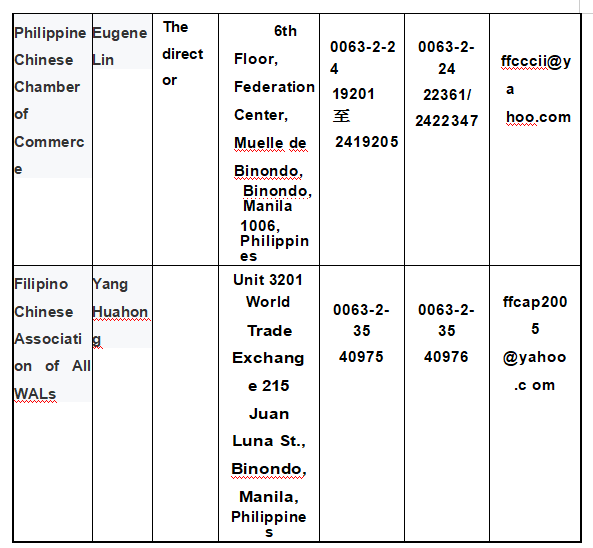
- Philippine Chinese Chamber of Commerce
Federation of Filipino-Chinese Chambers of Commerce & Industry, Inc
6th Floor, Federation Center, Muelle De Binondo St. Manila, Philippines.
Tel: 0063-2-2419201
Fax: 0063-2-2422361, 2422347
E-mail: secretariat @ ffcccii, com. Ph
Website: www.ffcccii.com.ph
There are more than 200 Chinese non-governmental organizations in the Philippines, such as chambers of commerce, clan associations, sports associations, and charitable organizations. However, the most influential Filipino Chinese Chamber of Commerce is the highest leading organization, the representative organization of Chinese people recognized by the mainstream society, and the society with the most concentrated human and financial resources.
Fe HuaShangLian association (hereinafter referred to as the "general") on March 29, was founded in 1954, which is mainly composed of unity, the Philippine business community is a non-profit organization, to coordinate the Philippine society the industrial, commercial, trade and financial activities, maintaining the harmonious relationship between each other, arbitration and mediation of disputes or differences between members, promote the cooperation between each other, At the same time, it supports the government's economic development to enhance the prosperity of the country.
With 170 member chambers of commerce all over the Philippines, it has become the most representative business organization in Philippine and Chinese society. Since its establishment, it has been dedicated to serving its members and continuously engaged in public welfare and charity undertakings. It has made active efforts in promoting mutual understanding and exchanges not only in the business community, but also in all areas of society. After 50 years of growth, it has now developed into a non-governmental organization of great benefit to national politics, economy and culture.
The General Chamber of Commerce has a well-organized structure, with a board of directors responsible for decision-making. There are 39 directors who serve two-year terms. The Standing Council and the Board of Governors are also involved in decision-making. The staff of its standing council includes: the president, the executive vice president, six vice presidents, directors, committee directors and deputy directors. Its main responsibilities are to oversee the work of the various committees and to coordinate the work of the Board of Directors and the Council.
The Board of Governors consists of at least 274 members, 156 of whom represent the Manila District and at least 7 from each of the 12 national districts. Each member serves a two-year term of office and is elected from among the delegates to the General Assembly of the Chamber of Commerce.
General has fourteen committee, responsible for the relevant aspects: the foreign relations committee, committee of industry and commerce and industrial relations (labor) committee, tax, financial and economic committee, welfare committee, the mediation committee, the agriculture committee, the organizing committee, culture and education committee, the green committee, press committee, property management committee, special plan committee. Each committee shall have a director, five vice-chairmen, several members and appointment members.
The following are the main members and their businesses:
Valentin Khoe coffee beans, produce
Huang Youheng NG Siu Seng sardine canned production, soy sauce
Sardine canning production by Pedro Yap
- Filipino Chinese Amity Club, Inc.
3rd FL. 542 T. Pinpin St., Binondo, Manila, Philippines.
Telephone: 0063-2-2426850, 2426851
Fax: 0063-2-2426850
E-mail: filchiamity@yahoo.com
The Philippines-China Friendship Association was founded in 1974, one year before the establishment of diplomatic relations between China and the Philippines. It is a non-profit non-governmental organization. The group aims to seek the lofty friendship and welfare among its members, to love the two countries and the friendship between the Philippines and China, and to promote the economic and cultural exchanges between the Philippines and China. It adopts the organizational principles of democratic centralism, the responsibility system of the president and collective leadership. Following the guiding ideology of sincere cooperation and solidarity, and following the principle of mutual respect, mutual trust and friendly cooperation with all the associations and people from all walks of life in the Philippines and China, we will work together to promote the economic prosperity of the two countries.
Philippine fellowship association is a patriotic group always adhere to the love of the motherland, as early as in 1974, in the Philippines is not before the establishment of diplomatic ties, should the founding director Dr Wu Yongyuan with nation, with some of the patriots for Chinese films in the Philippine capital Manila, to visit China at Max lady exhibition has made unremitting efforts. Since the establishment of diplomatic ties between China and the Philippines in 1975, the Association, with the strong support of the Chinese Embassy in the Philippines, has often invited Chinese friendly groups to visit the Philippines and played an important role in promoting China-Philippines friendship.
Early the establishment of diplomatic ties, the nation founded many patriots proposed Chinese newspapers, should under the social resistance, published in 1978, the fellowship weekly, receive the welcome of Chinese readers, after more than three years of development, founded after the world journal, now the world journal is full circulation of the largest Chinese language newspaper.
The Philippine Chinese Fellowship Association has more than 20 branches all over the country. The current president is Mr. Zheng Tianjin. In recent years, the association has organized large industrial and commercial delegations every year to visit China and carry out economic and trade exchange activities, such as Guangzhou Trade Fair, China-ASEAN Expo, China International Fair for Investment and Trade, Yiwu Small Commodities Fair, etc., making positive contributions to enhancing China-Philippines friendship and promoting economic development of the two countries.
- Chinese Filipino Business Club, Inc.
6th Floor Birch Tree Plaza Bldg., 825 Muelle de la Industria, Binondo, Manila, Philippines.
Telephone: 0063-2-2444991, 2444996
Fax: 0063-2-2444997, 2416475
Website: www.cfbc.com.ph
The association was established in 1998 as a non - profit business organization as a spin-off from the Federation of Commerce Associations. It has more than 400 members throughout the Philippines, and is the backbone of the Philippine business community. Its businesses include: manufacturing, banking, construction, retail, export, processing, etc.
Although the Chamber of Commerce has not been established for a long time, and its influence and status can not be compared with those time-honored large chambers of commerce, over the years, it has been committed to promoting economic development based on serving the Chinese community, and actively playing its role to help and support the government's various reforms, which has won recognition from all walks of life.
The Council has also made a lot of contributions to promoting and strengthening economic cooperation and exchanges between China and the Philippines, such as organizing business delegations to visit China and inviting Chinese enterprises that are interested in investing in the Philippines to visit the Philippines.
- Philippine Chinese Chamber of Commerce
Filipino-Chinese General Chamber of Commerce, Inc.
Address: 1122 Soler St., Manila, Philippines.
Telephone: 00632-7114141-232, 2447231
Fax: 00632-7436366, 2447635
The Philippine Chinese General Chamber of Commerce was founded in 1904 as the "China Bureau of Commerce". At the beginning of the 20th century, the overseas Chinese in the Philippines were discriminated against and ostracized due to ethnic estrangement and language barrier. Therefore, an organization that could fight for the rights and interests of the overseas Chinese and make overall plans for the whole situation was urgently needed. The association shouldered this historical responsibility. The association served the Chinese community loyally and safeguarded the interests of compatriots. Until the 1950s, it had been the highest leading organization of the Philippine Chinese community.
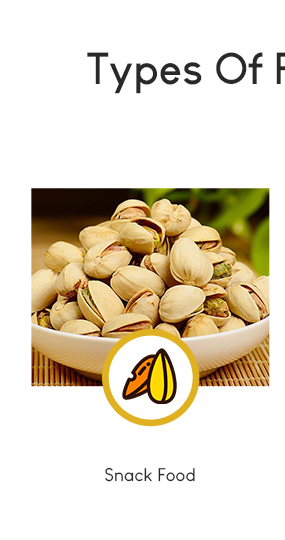 |
 |
 |
 |
||
 |
 |
 |
 |
||
 |
 |
 |
 |
||
 |
 |
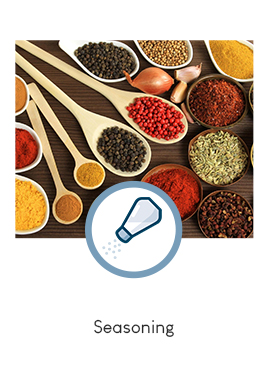 |
 |
||
 |
|||||
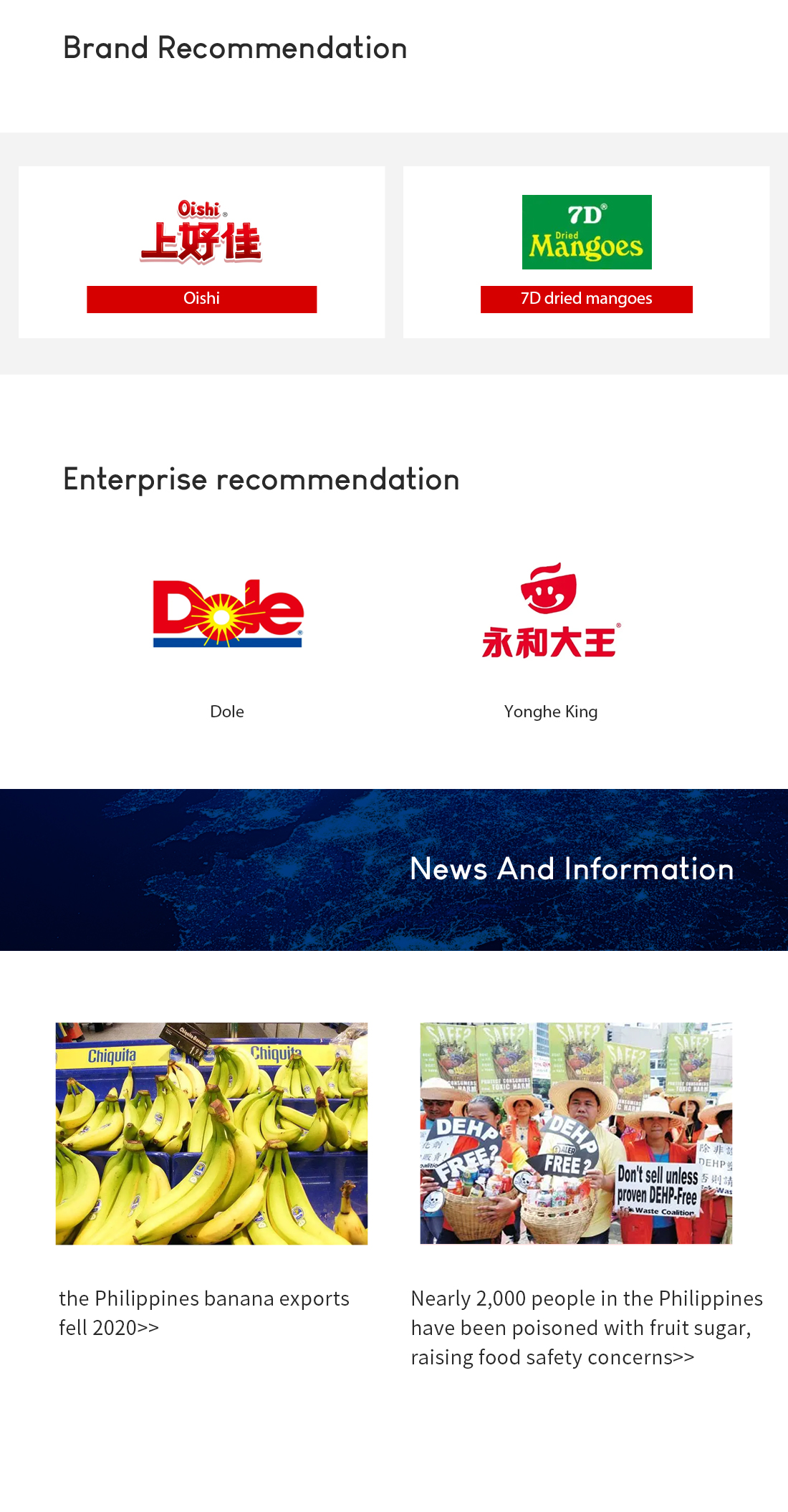
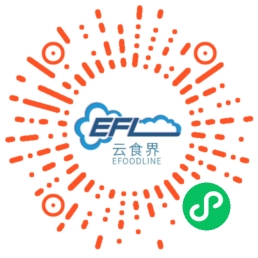 微信小程序
微信小程序



